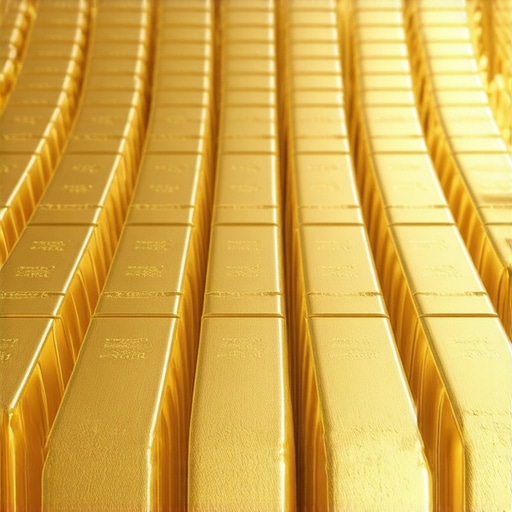Introduction to Gold Price Dynamics
Gold has long been considered a safe haven investment, especially during times of financial uncertainty. Understanding the factors that drive gold price fluctuations is crucial for investors looking to navigate the market effectively. As we enter 2025, several key elements will influence gold prices, making it imperative for both seasoned investors and newcomers to grasp these concepts.
Key Factors Influencing Gold Prices in 2025
To truly understand gold price fluctuations, one must consider various economic and geopolitical factors. These include inflation rates, interest rates, and the overall performance of the global economy. Inflation, in particular, has a direct correlation with gold prices; as inflation rises, the purchasing power of currency declines, leading investors to flock to gold as a more stable asset.
Inflation and Its Impact on Gold
As inflation rates are projected to rise in 2025, many investors are turning to gold as a hedge against this economic pressure. The relationship between inflation and gold prices is well-established; when inflation increases, the demand for gold often follows suit, pushing prices higher. This trend is particularly relevant as central banks around the world implement policies that may lead to inflationary pressures.
Interest Rates and Their Role
Interest rates also play a significant role in determining gold prices. Lower interest rates tend to weaken the dollar, making gold cheaper for foreign investors and consequently driving up demand. Conversely, when interest rates rise, gold may become less appealing as a non-yielding asset. As we move through 2025, monitoring central bank policies and interest rate adjustments will be crucial for understanding future gold pricing trends. Investors should stay informed about the 2025 gold market analysis, which will provide insights into how these factors are evolving.
Geopolitical Factors Affecting Gold Prices
In addition to economic indicators, geopolitical events can have a profound impact on gold prices. Tensions between countries, trade wars, and even natural disasters can lead to increased demand for gold as a safe haven. As 2025 unfolds, keeping an eye on global events will be essential for investors who wish to anticipate potential gold price movements. Understanding how central bank purchases influence gold demand is another critical piece of the puzzle.
As we delve deeper into the factors influencing gold prices, it becomes clear that a multifaceted approach is necessary for understanding the dynamics at play. By analyzing inflation rates, interest rates, and geopolitical events, investors can make more informed decisions about their gold investments. This comprehensive understanding will not only help in navigating the fluctuations but also in identifying optimal investment opportunities in the gold market.
Geopolitical Factors Affecting Gold Prices
In addition to economic indicators, geopolitical events can have a profound impact on gold prices. Tensions between countries, trade wars, and even natural disasters can lead to increased demand for gold as a safe haven. As 2025 unfolds, keeping an eye on global events will be essential for investors who wish to anticipate potential gold price movements. Understanding how central bank purchases influence gold demand is another critical piece of the puzzle.
Impact of Global Conflicts
Recent conflicts around the world have underscored the importance of geopolitical stability in determining the value of gold. When uncertainty rises, investors typically seek refuge in gold, driving up its price. For instance, ongoing tensions in regions such as the Middle East and Eastern Europe can create fluctuations in gold prices as investors react to the potential for increased conflict. Therefore, staying informed about global conflicts will be crucial for forecasting the gold market in 2025.
Trade Wars and Their Consequences
Trade wars can also significantly impact gold prices. As countries impose tariffs and trade barriers, economic growth can stall, leading to greater uncertainty in financial markets. In 2025, if trade tensions escalate, we may see a corresponding increase in gold demand as a hedge against economic instability. Investors should closely monitor developments related to trade policies and their implications for gold prices.
Market Trends Influencing Gold Prices
Beyond geopolitical factors, various market trends also play a significant role in shaping gold prices. Understanding these trends can help investors make informed decisions. For instance, the trends in gold demand from different sectors, including jewelry, technology, and investment, are crucial to forecasting price movements.
Technological Advancements and Gold Demand
As technology evolves, so too does the demand for gold in various applications, particularly in electronics and renewable energy. With the rise of green technology, gold is increasingly used in production processes, creating additional demand. Investors should consider how technological advancements may impact gold prices in the coming years. For insights into this topic, refer to our article on gold demand trends.
Investor Sentiment and Market Psychology
Investor sentiment can also sway gold prices dramatically. Market psychology often leads to price bubbles or crashes as investors collectively react to external events. Understanding the prevailing sentiment around gold can provide clues about potential price movements. For example, during periods of economic downturn, investor sentiment typically shifts towards gold, resulting in higher prices.
As we navigate through 2025, it will be vital for investors to analyze not only the economic and geopolitical landscapes but also the psychological factors influencing market behavior. By integrating these insights, investors can better position themselves to capitalize on opportunities and mitigate risks in the gold market.
Market Trends Influencing Gold Prices in 2025
Beyond geopolitical factors, various market trends also play a significant role in shaping gold prices. Understanding these trends can help investors make informed decisions. For instance, the trends in gold demand from different sectors, including jewelry, technology, and investment, are crucial to forecasting price movements.
Technological Advancements and Gold Demand
As technology evolves, so too does the demand for gold in various applications, particularly in electronics and renewable energy. With the rise of green technology, gold is increasingly used in production processes, creating additional demand. Investors should consider how technological advancements may impact gold prices in the coming years. For insights into this topic, refer to our article on gold demand trends.
Investor Sentiment and Market Psychology
Investor sentiment can also sway gold prices dramatically. Market psychology often leads to price bubbles or crashes as investors collectively react to external events. Understanding the prevailing sentiment around gold can provide clues about potential price movements. For example, during periods of economic downturn, investor sentiment typically shifts towards gold, resulting in higher prices.
Gold Demand from Jewelry and Investment Sectors
The jewelry sector remains one of the largest consumers of gold, especially in regions like India and China, where gold jewelry is an integral part of cultural celebrations. As consumer demand fluctuates due to economic conditions, this can significantly impact gold prices. In addition to jewelry, investment demand in the form of gold ETFs and coins also plays a critical role. Tracking shifts in these markets provides insights into potential price trends. For a deeper understanding, check our article on gold price fluctuations.
Global Economic Recovery and Its Effect on Gold Prices
As the global economy begins to recover from recent shocks, the interplay between economic growth and gold prices becomes increasingly complex. Typically, in a recovering economy, demand for gold can decline as investors seek higher-yielding assets. However, uncertainty in recovery can lead to increased gold purchases as a safeguard against potential downturns. Investors should monitor global economic indicators closely to predict how recovery trends may influence gold pricing.
Central Banks and Their Gold Reserves
Central banks worldwide continue to buy gold as part of their reserve management strategies. In 2025, their purchasing decisions will significantly influence market dynamics. Understanding how central bank purchases impact gold demand is crucial for anticipating price movements. Increased central bank buying often signals confidence in gold as a stable asset, which can lead to price increases.
Inflation as a Driving Force
Inflation remains a persistent concern for investors, especially with rising costs in various sectors. As inflation rates rise, the appeal of gold as a hedge against currency depreciation grows. This relationship between inflation and gold prices is vital for investors to understand, particularly as central banks adjust their monetary policies. For a comprehensive look at how inflation affects gold prices, visit our article on inflation and gold prices.
In summary, the landscape of gold prices in 2025 will be shaped by a combination of technological advancements, shifts in investor sentiment, and the ongoing influence of central banks. By staying informed about these factors, investors can better position themselves for potential opportunities in the gold market.
Global Economic Recovery and Its Effect on Gold Prices
As the global economy begins to recover from recent shocks, the interplay between economic growth and gold prices becomes increasingly complex. Typically, in a recovering economy, demand for gold can decline as investors seek higher-yielding assets. However, uncertainty in recovery can lead to increased gold purchases as a safeguard against potential downturns. Investors should monitor global economic indicators closely to predict how recovery trends may influence gold pricing. For deeper insights into this topic, explore our article on 2025 gold market analysis.
Central Banks and Their Gold Reserves
Central banks worldwide continue to buy gold as part of their reserve management strategies. In 2025, their purchasing decisions will significantly influence market dynamics. Understanding how central bank purchases impact gold demand is crucial for anticipating price movements. Increased central bank buying often signals confidence in gold as a stable asset, which can lead to price increases. This behavior is particularly relevant for investors looking to gauge market confidence and future trends.
Inflation as a Driving Force
Inflation remains a persistent concern for investors, especially with rising costs in various sectors. As inflation rates rise, the appeal of gold as a hedge against currency depreciation grows. This relationship between inflation and gold prices is vital for investors to understand, particularly as central banks adjust their monetary policies. For a comprehensive look at how inflation affects gold prices, visit our article on inflation and gold prices.
Gold Demand from Jewelry and Investment Sectors in 2025
The jewelry sector remains one of the largest consumers of gold, especially in regions like India and China, where gold jewelry is an integral part of cultural celebrations. As consumer demand fluctuates due to economic conditions, this can significantly impact gold prices. In addition to jewelry, investment demand in the form of gold ETFs and coins also plays a critical role. Tracking shifts in these markets provides insights into potential price trends. For a deeper understanding, check our article on gold price fluctuations.
Emerging Markets and Their Influence
Emerging markets are increasingly playing a vital role in gold demand. Countries like India and China, with their growing middle classes, are expected to drive significant increases in gold consumption. The cultural significance of gold in these regions continues to fuel demand, making them crucial players in the global gold market. Investors should pay attention to trends in these markets as they can substantially influence global gold prices.
Technological Innovations and Their Impact on Gold Demand
Technological advancements also contribute to shaping gold demand, particularly in sectors like electronics and renewable energy. As technology evolves, gold’s role in various applications expands, leading to increased demand. Investors should consider how innovations in technology, including the rise of green technology, may impact gold prices in the coming years. For insights into this topic, refer to our article on gold demand trends.
Gold as a Component in Renewable Energy Technologies
With the increasing emphasis on sustainable energy sources, gold is being utilized in the production of solar panels and other green technologies. This trend is expected to bolster demand, providing another layer of complexity to gold pricing. Investors keen on understanding the future of gold should monitor developments in the renewable energy sector closely.
Frequently Asked Questions (FAQ) about Gold Prices
What are the primary factors influencing gold prices in 2025?
The primary factors influencing gold prices in 2025 include inflation rates, interest rates, geopolitical tensions, and market demand from various sectors such as jewelry and technology. Understanding these dynamics is essential for investors looking to navigate the gold market effectively.
How does inflation affect gold prices?
Inflation directly affects gold prices by diminishing the purchasing power of currency. As inflation rises, investors often turn to gold as a hedge, increasing demand and consequently driving up prices. This relationship is particularly strong in periods of high inflation.
Are there specific geopolitical events that can impact gold prices?
Yes, geopolitical events such as conflicts, trade wars, and political instability can significantly impact gold prices. Investors typically seek refuge in gold during times of uncertainty, which can lead to price increases. Monitoring global events is crucial for predicting potential market movements.
What role do central banks play in gold prices?
Central banks play a significant role in gold prices through their purchasing strategies. Increased gold purchases by central banks often indicate confidence in gold as a stable asset, which can boost prices. Investors should stay informed about central bank activities to understand market dynamics.
How does investor sentiment influence gold prices?
Investor sentiment can greatly influence gold prices, often leading to price fluctuations based on collective market psychology. During periods of economic downturn, for instance, sentiment tends to shift towards gold, causing prices to rise as demand increases.
What are the trends in gold demand from emerging markets?
Emerging markets, particularly in Asia, are becoming crucial players in gold demand. Countries like India and China, with growing middle classes and cultural affinities for gold, are expected to drive significant increases in consumption, positively impacting global gold prices.
How do technological advancements affect gold prices?
Technological advancements, especially in electronics and renewable energy, are increasing the demand for gold. Innovations in green technology, for instance, are leading to new applications for gold, thus enhancing its demand and influencing prices.
What is the outlook for gold prices in 2025?
The outlook for gold prices in 2025 remains cautiously optimistic. Factors such as rising inflation, ongoing geopolitical tensions, and increased demand from emerging markets and technology sectors are likely to support higher gold prices. However, market volatility and external economic conditions will also play a crucial role.
How can I stay informed about gold market trends?
To stay informed about gold market trends, investors can follow trusted financial news sources, subscribe to market analysis reports, and consult expert opinions. Websites such as Kitco, World Gold Council, and Bloomberg provide valuable insights into gold market dynamics.
Authority Resources for Gold Price Insights
To deepen your understanding of gold price dynamics and market trends, here are some authoritative resources:
- Kitco – A leading platform for gold market news and prices.
- World Gold Council – An authoritative source of information on gold demand trends, investment insights, and market analysis.
- Bloomberg – Offers comprehensive financial news and data, including insights on gold market trends.
- Reuters – Provides news and analysis on commodities, including gold.
- Forbes – Features articles on investment strategies, including insights into the gold market.
Conclusion
In conclusion, understanding the factors influencing gold prices in 2025 is essential for investors seeking to make informed decisions in this dynamic market. By analyzing economic indicators, geopolitical events, and market sentiment, coupled with insights from authoritative resources, investors can better position themselves to navigate the complexities of gold investments. As we move forward, staying informed about inflation, central bank activities, and technological advancements will prove vital in predicting gold price trends and maximizing investment opportunities.










This comprehensive overview of gold price influences for 2025 really highlights how multifaceted the market is. I’ve been following the trend of central banks increasing their reserves, especially in uncertain geopolitical times, which seems to support the idea that gold remains a strong hedge. Personally, I’ve been considering diversifying my portfolio with more gold assets, but I wonder how the rising tech demand might balance against the traditional jewelry and investment sectors. Do you think emerging markets’ increased consumption could lead to a sustained high demand, or might it stabilize once those markets reach a certain saturation point? It seems crucial to monitor not only the economic indicators but also technological innovations that could either boost or dampen gold’s role in various industries. This makes me curious—what strategies have other investors found effective in navigating these complex influences? It’s a dynamic landscape, and staying informed will definitely be key to making sound decisions.
This article really underscores how complex the factors influencing gold prices are for 2025. I’ve personally been watching central bank gold reserves, as it seems they’re quite optimistic about gold’s stability amid geopolitical tensions. What intrigues me is the potential impact of rising technological demands, especially in green energy and electronics, on long-term gold prices. I wonder, has anyone looked into how sustainable this increased demand will be, or could it peak once new applications become mainstream? Also, I’m curious about how investors might balance these technological factors with traditional safe haven strategies. It seems like staying ahead requires keeping an eye on both economic indicators and innovation trends. For those of you who already diversify with gold, what mix of sectors or regions do you find most effective for mitigating risks in such a fluctuating environment? I’d love to hear others’ approaches to managing this dynamic landscape.